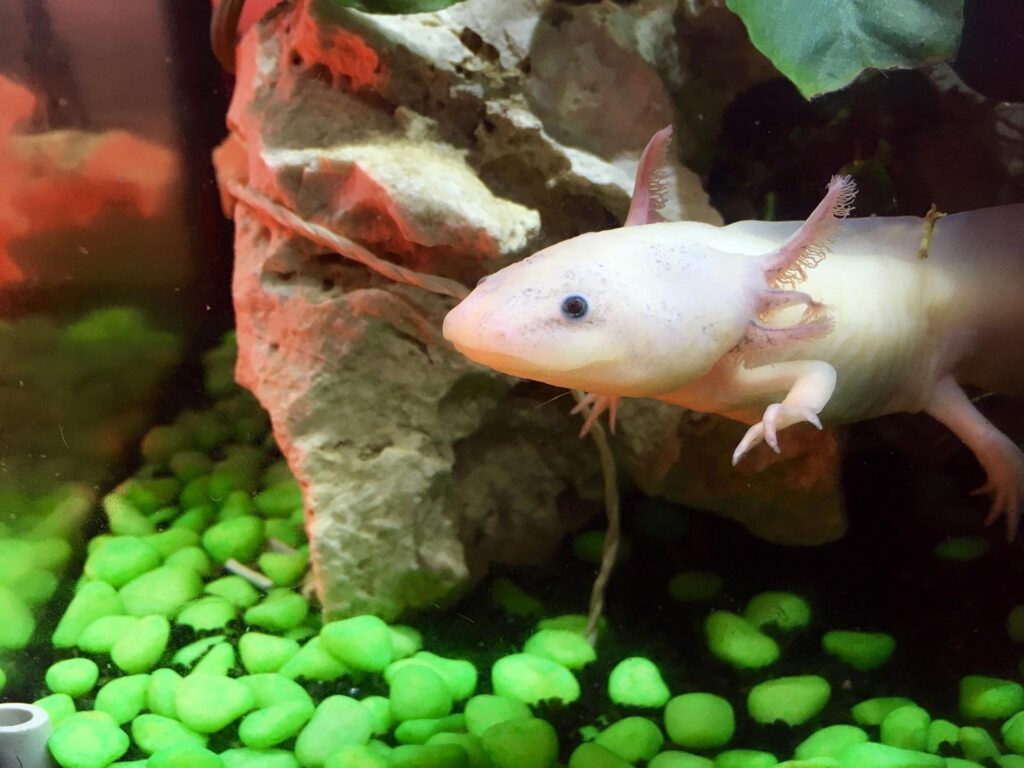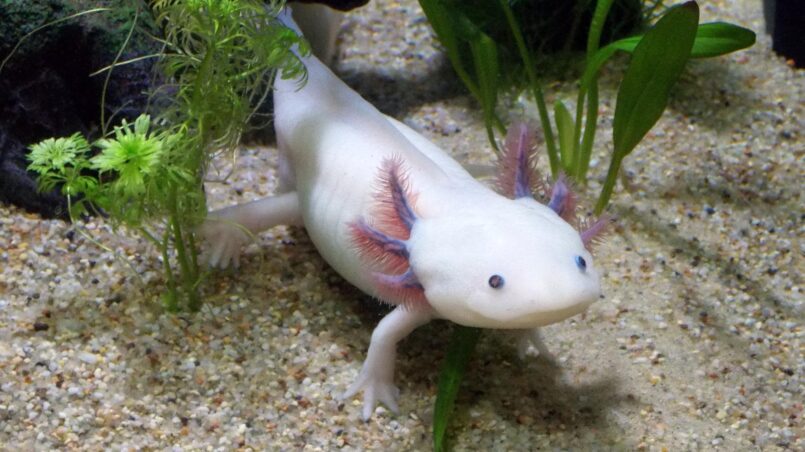You’ve probably seen axolotls in aquariums and science museums, but did you know that these unique creatures can be found wild in some parts of India? Axolotls are one of the most popular kinds of amphibians that you can keep as pets at home, but not everyone knows much about them or understands what makes them such perfect creatures to share your life with.
In this post, we’ll take a closer look at the axolotl price in India and learn more about its mysterious and wonderful world.
Axolotl Price in India
The price of Axolotl depends upon various factors like availability of the animal, location for where you buy it and seller reputation but in general if you want to buy Axolotl in India then it will cost you around Rs.4,000 to Rs.9,000.
Is Axolotl Legal in India?
Axolotls are a protected species in India, so you need a permit to own one. This means, they are legal in India and can be kept as pets perfectly. Because this species is not Indian and is not covered by the Indian Wildlife Protection Act.

Do Axolotls Make Great Pets?
The axolotl (Ambystoma mexicanum) is a relative of the salamander, and a type of neotenic salamander, meaning it can live its entire life in a larval form. Like other amphibians, these animals breathe through their skin and lungs. They are also known as the Mexican walking fish because they walk along the bottom of shallow bodies of water on their front legs with their rear legs propelling them forward. These animals are not big swimmers but they can wriggle surprisingly quickly over land.
Space Requirements for Axolotl
Mature axolotls require a lot of space. They need at least a 20-gallon tank, and that’s only if you’re planning on keeping one. If you’re thinking of getting a colony, you’ll need something much bigger. Make sure you have a tight-fitting lid on your tank, otherwise your axolotl will escape and you’ll be hunting all over for him (or her).
Tank Setup for Axolotl
They’re such amazing creatures. When setting up their tank, there are a few things you’ll want to keep in mind. The first is size. Axolotls can grow to be quite large, so make sure you have a tank that’s big enough. You’ll also want to make sure the water is deep enough so they can swim around. You can use plants, tree trunks, rocks, etc. Make sure to leave plenty of places where Absolutely can hide and feel safe.
Caring for an Axolotl
So you’ve decided to adopt an axolotl! Congratulations! Now comes the hard part: taking care of your new pet.
There are a few different factors to take into consideration when caring for an axolotl. The first is the tank size and type of enclosure, as well as its decor. A 20-gallon aquarium would be a suitable size for an axolotl.
The second factor to consider is water depth. Axolotls should be provided with a deep, secure area to rest while they’re not swimming around.
Water Conditions for Axolotl
When it comes to water conditions for the axolotl, you need to remember that they’re creatures that come from a freshwater environment. So you’ll need to create a tank that replicates that as closely as possible.
Axolotls are freshwater creatures, so you’ll need to provide them with a tank that’s big enough to swim in. The water should be clean and have a pH level of 6.5-7.5. The temperature should be kept for the best between 60 and 64 degrees. And remember to change the water regularly, at least every other week.
Feeding for Axolotl
Axolotls are carnivorous animals that feed mainly on worms, insects, crustaceans, and small fish. They’re not particularly fussy eaters, but you should give them a balanced diet that includes both live and frozen food.
Your axolotl will need to eat a diet that’s high in protein. Feeding your axolotl is easy because they need to eat only two or three times each week. Usually, you would feed them a fish and small mice, but it’s best to talk to a pet store specialist first before buying anything.
Axolotl Temperament and Personality
When it comes to the axolotl, there’s a lot of mystery surrounding it. And that’s because these creatures have an amazing temperament and personality. For one, they’re very curious and playful. They love to explore their surroundings and will often get themselves into trouble as a result.
Axolotls are also very social animals and love to be around other axolotls. In the wild, they live in colonies and share responsibilities like hunting and caring for their young.
Handling Axolotl
When you’re handling axolotl, it’s important to be gentle. These creatures are delicate and can easily get injured. The best way to hold them is to cup your hand underneath their body and support their head with your thumb. Be careful not to squeeze or pinch them, and always avoid getting them out of their water.
Axolotl Lifespan
Axolotls have a long lifespan an average of 10 years some of them have been known to live for up to 20 years! And as they age, their appearance doesn’t change all that much. So you could have an axolotl that’s been living in your tank for years, and you might not even know it.
Also Read: Gold Fish Price in India (September 2022) – Pets Expert
10 Strange Facts About Axolotls
1) The Axolotl Can Regenerate Entire Limbs
Axolotls can regenerate lost limbs, spinal cord, heart, and even parts of their brain. Not only do they retain their physical appearance but also their behaviour. The axolotl can grow an entirely new body from scratch within a matter of weeks! Scientists are hoping that by studying the axolotl they can unlock secrets on how to regenerate tissue in humans.
2) Axolotl Can Regrow the Same Limb Up To 5 Times
Their limb regeneration is something that sets them apart from every other vertebrate in the world. However, this special ability has a limit. After five times, the axolotl stops being able to regenerate its limbs.
3) The Average Lifespan of an Axolotl in Captivity is 10 Years
The average lifespan of an axolotl in captivity is 10 years and with proper care up to 20 years. When an axolotl goes through metamorphosis, it grows gills for the first few weeks, before developing lungs and legs.
4) Axolotl are Only be Found in Mexico
Axolotls are more often than not brown or dark in colour, making them easily camouflaged when they live in the wild. So it’s unsurprising that only about one per cent of the wild axolotls living in Southern Mexico City are white.
5) They have a Mythological Background
The name axolotl is a combination of the Nahuatl words ax which means water, and Xolotl which means dog. Some people believe that they are reincarnated Aztec deities. In Mexico, they are known as water dogs or Mexican walking fish because they walk on their front fins to move around like land animals.
6) Wild Axolotls are Rarely White
White ones are known as leucistic – leucism is a condition that reduces the number of pigmentation cells in an animal’s skin or scales. This causes animals to be lighter than normal, with white patches of fur, or different-coloured eyes.
7) Axolotl Does not Chew its Food
Axolotls, with their strange eel-like bodies, are one of the world’s weirdest creatures. It may be hard to believe that they can’t chew their food as mammals do.
8) Their Feathery Headdress is not Just for Show
Axolotls also have fascinating feathery headdresses. Unlike other species of salamanders, axolotls do not lose their gills as they mature; instead, they grow feathery filaments that protrude from the sides of their heads to allow them to breathe air directly when necessary.
9) Word Axolotl Comes From the Ancient Aztecs
This bizarre creature—whose name comes from the Aztec words meaning water monster—has existed for centuries in the murky waters of Mexico’s lakes. Originally classified as a type of salamander, it was later found to be more closely related to lizards and may be an evolutionary offshoot from terrestrial amphibians like frogs.
10) Researchers are Encouraging Axolotl to Breed
While axolotls are endangered, scientists are going to great lengths to save the creatures. They’re raising thousands of axolotls in laboratories.
Summing Up on Axolotl Price in India
When it comes to the axolotl, there’s no doubt that it’s one of the most fascinating creatures on the planet. While they’re not always easy to find, an encounter with an axolotl in India is an experience you won’t forget. We hope you’ve enjoyed getting to know a little bit more about these incredible creatures.
FAQs
Are Axolotls Poisonous?
No, healthy Axolotls are not dangerous and there is no risk of being poisoned. However, too much stress or mishandling can lead to a nasty bacterial infection.
How Long Can Axolotl Stay Out of Water?
A typical axolotl is only able to adjust out of water for an hour at most, but they are more likely to stay dry when given a safe environment.
Can Axolotls Live in Tap Water
Tap water is fine for axolotls as long as it is treated with a conditioner that neutralizes the chlorine. The axolotl tank should also be filled with well-filtered water.
Do Axolotls Like to Be Touched?
Axolotls do not like to be handled or touched that much. If it is necessary, always be very careful with their head before handling the axolotl.
How Hard Do Axolotls Bite?
Axolotls have teeth, but their teeth aren’t even sharp enough to puncture human skin. These amphibians instead use their mouth to suck on fish or other small invertebrates that they can consume.
Are Axolotls Smart?
Axolotls are highly intelligent and make great pets. They are capable of communicating with humans due to their complex brain structures.



